May 29, 2025 | 07:42 GMT +7
May 29, 2025 | 07:42 GMT +7
Hotline: 0913.378.918
May 29, 2025 | 07:42 GMT +7
Hotline: 0913.378.918
The Sustainable Mariculture Development Conference - Insights from Quang Ninh, held on April 1 in Quang Ninh province, has inspired numerous solutions, dismantled barriers, and established development strategies for the fisheries sector. Coastal provinces and cities have combined their efforts to rearrange marine spaces, allocate marine areas for mariculture, develop infrastructure to support fishing activities both on land and at sea, and refine legal frameworks and policy mechanisms for mariculture. Businesses and investors are implementing scientific and technological advancements, and establishing partnerships with scientists and research institutes to devise mariculture strategies. Advanced, modern, diversified, and value-added mariculture models are emerging across all coastal regions of the country, marking the beginning of a new phase for Vietnam's aquaculture industry.
In 2013, Mr. Bui Duc Duong, a member of Thang Loi Cooperative, used two wooden rafts to guide his farming cages from Cat Ba to Bai Tu Long Bay in search of a "new waters."
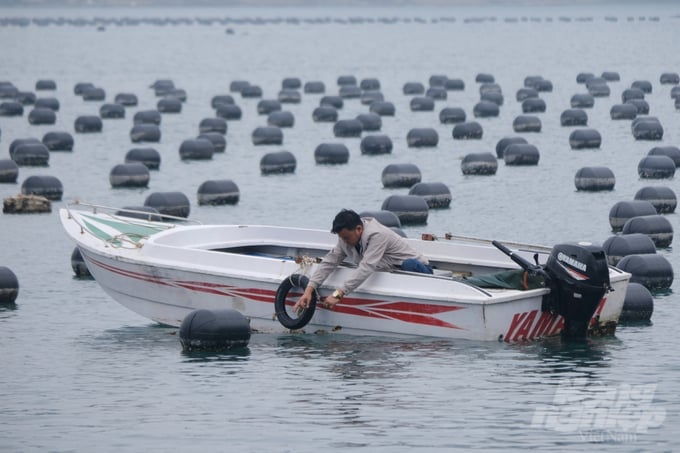
Oyster farming in Bai Tu Long Bay, Van Don district, Quang Ninh province. Photo: Kien Trung.
"Where did I get such motivation back then? It was a fifty-kilometer journey across the sea. I gathered 20 wooden cages, along with farming nets, cage ropes, floating buoys, to pile onto the rafts. The massive structure was moved from Cat Ba to Van Don in exactly 48 hours. Can you imagine doing it all over again?" Duong reminisced.
"A farming cage raft is a production asset; it is an inseparable possession of the farmers on the sea. The water surface area, or broadly speaking, marine surface area, is a prerequisite for farmers. Consequently, mariculture farmers will not be able to develop without these two crucial factors. During the early 2000s, they were a major asset for farmers; people would exchange land use rights certificates for mariculture tools, or use them as collateral for loans," Duong recounted.
His venture into oyster farming on a wooden raft in the waters of Cat Ba ultimately failed. Accordingly, the farming yield was unstable; his oysters were regularly sick, resulting in mass deaths. As a result, the entire business venture went bankrupt.
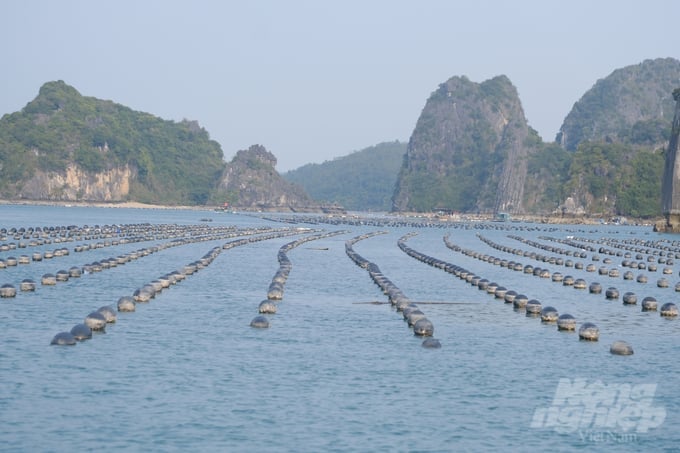
Mariculture in Bai Tu Long Bay. Photo: Kien Trung.
Hailing from Quang Yen district in Quang Ninh province and marrying into Cat Ba town, Hai Phong city, both of Duong's families have a tradition of aquaculture. Consequently, Bui Duc Duong utilized his strongest asset, experience, to establish himself. At 43 years old, he has spent 30 years fully engaged in the profession. He has spent more time on the raft and amidst the sea than on land
"Cat Ba's marine area was selected for numerous development projects in 2013, resulting in unstable farming areas and polluted waters, forcing us to relocate. With two wooden rafts on both sides of the farming cage rafts, we pushed forward at a snail's pace. We went with the water's flow and relied on the tide to propel the rafts. We'd stop whenever the flow reversed, or if we went against the wind. Thankfully, during those days, the sea was not congested with boats and rafts, allowing us to sail on our own path. Nowadays, it's impossible because the farming areas are tightly packed together, making it impossible to navigate through oyster farming nets, floating cages for fish, etc., with an entire fleet of farming cages behind you."
Ultimately, Duong chose to anchor his rafts in "Kep Khi Nhay" basin. The surrounding standing islands forms an enclosed basin shielded from wind and waves. The rafts are placed against the Bai Tu Long Bay Conservation Area, filled with lush greenery. With the help of other mariculture households in the area, they laid pipelines from the mountaintop to ensure freshwater supply, eliminating the need to purchase freshwater. It is a natural advantage, and one of the reasons why Duong decided to settle in.
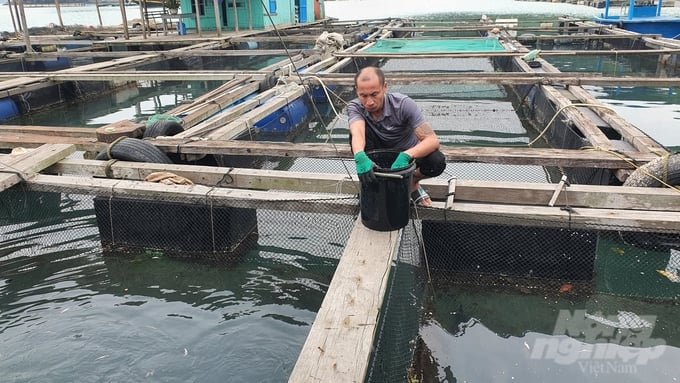
Mr. Bui Duc Duong currently owns a fish farming area with over 20 cages in the Kep Khi Nhay basin, Thang Loi island commune.

Daily life on fish farming rafts amidst the open sea of the mariculture farmers in Van Don. Photo: Hoang Anh.
Pointing to a narrow mountain cleft within arm's reach, with two neighboring islands forming two mountain peaks leaning against one another, Mr. Duong explained: "occasionally, a troop of monkeys would leap from one peak to another, which is why this place is called "Kep Khi Nhay" (Vietnamese for Jumping Monkey Basin) to distinguish it from other bays. Each island protruding from the sea serves as a natural sturdy wall sheltering the fish farming areas from waves and wind, limiting storms, and keeping the water calm for the farmers to tend to their work in relative safety."
The Kep Khi Nhay basin is home to five to six mariculture households, all of which are highly experienced in the profession. Each household manages several hectares of marine surface area, using the surrounding natural islands to delineate borders. Sheltering behind the islands, farming rafts are placed leaning against the mountainsides, and anchored by sturdy ropes securely fastened to deep poles submerged underwater.
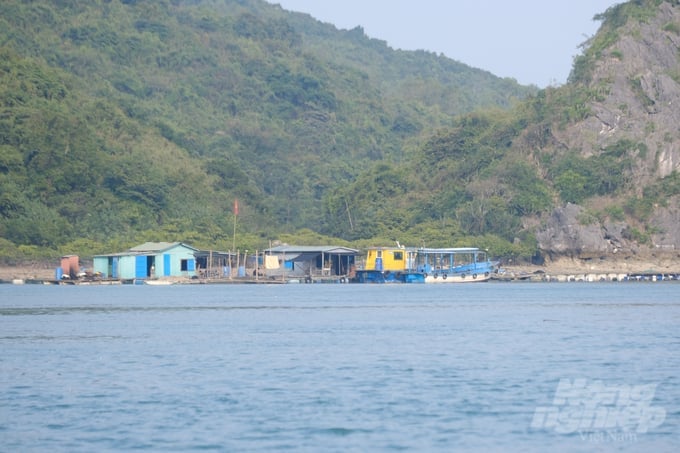
Each household in Van Don places their farming cages leaning against a mountain in the sea.
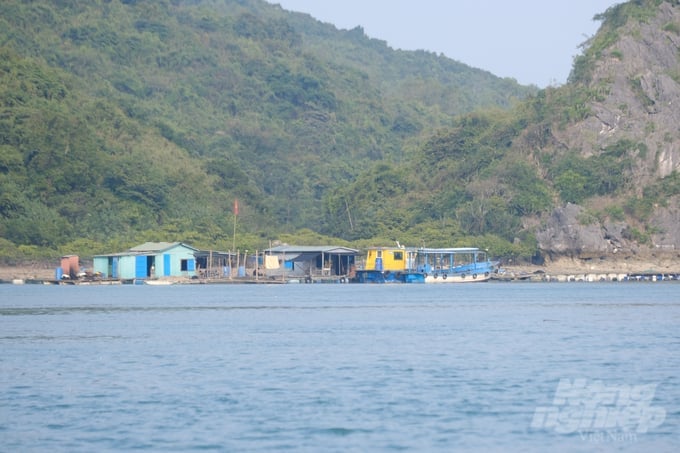
The mountains serve as walls for the farming cages, providing shelter from wind and waves.
Each household's mariculture area is distinguishable by its accompanying small wooden houses. Although makeshift and rudimentary, the houses made from planks and assembled wood are relatively sturdy, and firmly placed in one corner of the raft. These are the residence of local mariculture farmers.
Floating rafts with wooden planks as walkways and nets hanging down into the water are farming rafts. On the other hand, stationary black plastic buoys marks submerged oyster farming lines. Each oyster farming line consists of 25 buoys; each buoy carries 10 to 12 oyster bags; 13 oyster lines fill up 1 hectare of water surface area. Additionally, the lines are spaced at least 1 meter apart to create space for oysters to breathe and grow. The oyster farming areas are meticulously arranged, with little room for error.
March is typically the time when the sea is the calmest, so calm that even an old lady can sail the seas based on folk wisdom. Along the coastline spanning over 3,000 kilometers from the north to the south of Vietnam, the Northeastern sea is considered to be "calmest" region. And the enclosed bays sheltered from the waves and wind in Bai Tu Long Bay are the most peaceful areas in the Northeastern sea, including the Kep Khi Nhay basin where Duong resides.
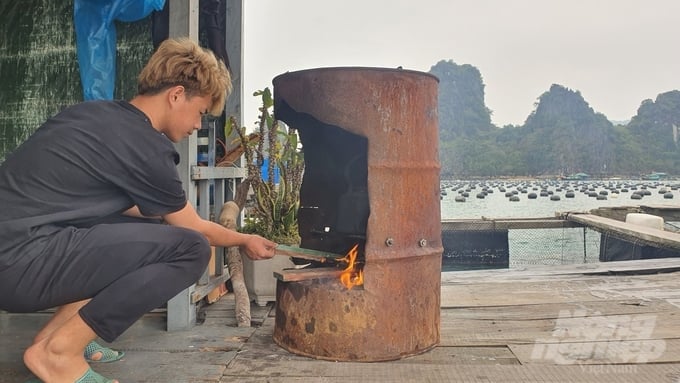
A makeshift stove put together by mariculture farmers. Photo: Hoang Anh.
A day in the life of mariculture farmers is a largely repetitive sequence: in the morning, they check the farming rafts and feed the fish. In the afternoon, they inspect the oyster farming lines. Every few days or weeks, they check the natural fish traps to collect the caught fish, and place them in the farming areas. Accordingly, naturally trapped fish is another source of fish seed for mariculture farmers in Van Don.
Notably, Mr. Duong's mariculture area houses a seven-year-old compartment reserved for a small population of grouper. Walking along the 20-centimeter wide wooden planks on the raft, Duong holds a container of small fish in his hand - food for the grouper. He scatters them into the water, one handful at a time. Within minutes, large groupers emerge from under the murky water. Notably, a grouper can reach between 30 and 60 kilograms in weight.
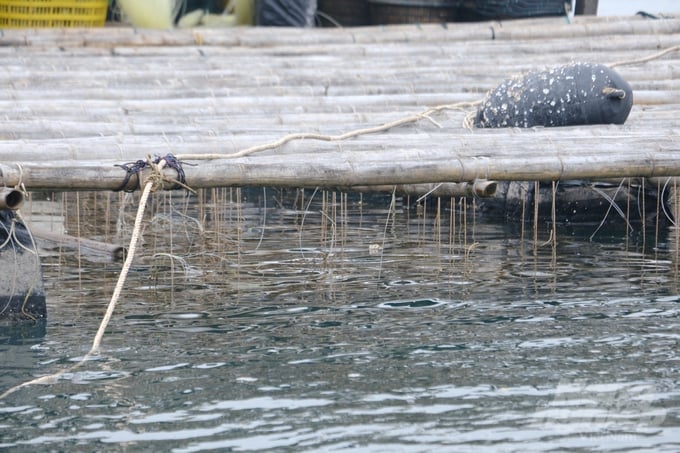
Oyster seed farming in the waters of Quang Ninh.
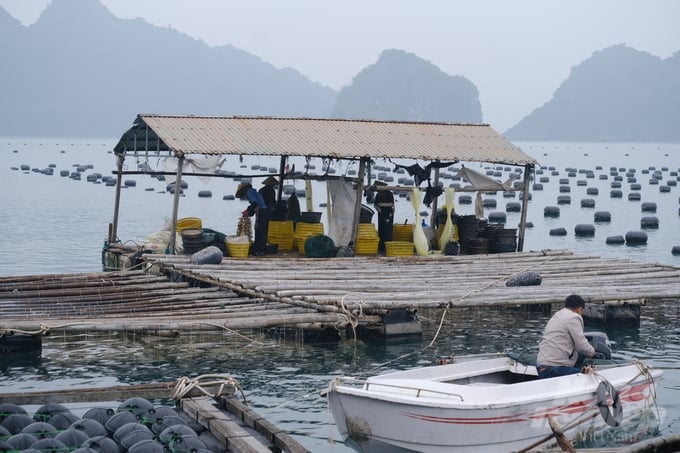
With policies to promote the allocation of long-term marine areas, mariculture farmers are provided with production materials, and certified production unit codes for their farming areas, thereby enhancing the value of their mariculture products. Photo: Hoang Anh.
Duong's large-sized groupers are typically purchased by traders at the price of 1 million Vietnamese dong per kilogram. Subsequently, the fish can double or triple in value by the time it reaches the consumers. With this price range, Duong is currently raising several millions of Vietnamese dong worth of fish underwater; and that is the value of a single fish farming compartment. The remaining 19 compartments also house fish weighing approximately three to five kilograms each.
Towards the end of the raft, Bui Duc Hung, Duong's younger brother, is sawing and splitting a fresh log. "I'm making a makeshift oar. In order to check on the rafts, cages, and oyster farming lines, you need an oar to carefully row through each line," Hung explains. Another young man is preparing dinner in a makeshift stove. The stove is improvised from an oil drum, with one-fourth of it hollowed out to serve as a door, and the rest functioning as both a chimney and a barrier. Amidst the sea, with nothing but water and wind, the makeshift stove provides its own shelter from rain and wind.
Nguyen Van Khanh, born in 1981, is one of Duong's neighbors. Khanh, originally from Van Don, has extensive experience in cage fish farming. Despite his small stature, Khanh has been weathered by the storm; and his family has been engaged in cage fish farming for over a decade.
Khanh places natural fish trap cages around his raft to catch fish seed. These traps have one open entrance and no exit, with fish bait placed in front of the trap. Every few days, Khanh lifts the traps to collect the caught fish, which primarily consists of spinefoot, spotted scat, triggerfish, and grouper. After sorting them by species, Khanh places them in the natural farming cages, and feeds them at intervals. Accordingly, Khanh has caught approximately 30,000 fish since late 2023. After one year of farming, the mature fish can reach a weight of 200 grams each, for a total harvest of approximately 6 tons. Subsequently, the harvested fish are sold to traders at prices ranging from 190,000 to 200,000 Vietnamese dong per kilogram.
At the end of the day, when work has quieted down, rafts from the mariculture areas of Mr. Duong, Mr. Cuong, and Mr. Thinh can be heard approaching Mr. Khanh's. The mariculture community within Kep Khi Nhay basin often gathers for such meetings, to brew a pot of tea and chat about mariculture, family matters on land, and their children's education. These gatherings have become more frequent in the last few months as mariculture farmers in Van Don are eager to join the cooperative, which is a precursor to obtaining marine areas to establish mariculture zones, and ultimately, expanding the scale of production. Consequently, Quang Ninh is a pioneer in allocating marine areas for mariculture.
Translated by Nguyen Hai Long
/2025/05/25/4127-3-073637_820.jpg)
(VAN) Thanks to the promotion from an FAO-implemented project, vegetable production in greenhouses in Moc Chau has seen strong development, from 1.5 hectares in 2021 to nearly 50 hectares in 2024.

(VAN) FAO has recently supported USD 140,000 to implement the project 'Risk mitigation human-animal interface risks through disease control initiatives in pig farming.'

(VAN) The People's Committee of Tra Vinh province has approved an adjustment to the investment policy for the Green Hydrogen Plant project, increasing its area to approximately 52.76 hectares.
![Reducing emissions from rice fields: [2] Farmers’ commitment to the soil](https://t.ex-cdn.com/nongnghiepmoitruong.vn/608w/files/news/2025/05/05/dsc08881jpg-nongnghiep-140632.jpg)
(VAN) Clean rice cultivation model in Thuong Tan commune, Bac Tan Uyen district, is assisting local residents in achieving sustainable agriculture by substantially reducing costs, increasing productivity, and protecting the environment.

(VAN) At the conference to disseminate Resolution No. 68, AgriS introduced its digital agricultural ecosystem and reaffirmed its commitment to accompanying the Government in promoting private sector development and sustainable agriculture.

(VAN) 'Blue Ocean - Blue Foods' initiative is designed to restore marine ecosystems and establish sustainable livelihoods for local communities by cultivating a minimum of 1,000 hectares of cottonii seaweed in the first three years.
/2025/05/21/4642-3-112707_603.jpg)
(VAN) The V-SCOPE project has made direct contributions to three out of six pillars of the Comprehensive Strategic Partnership between Vietnam and Australia.